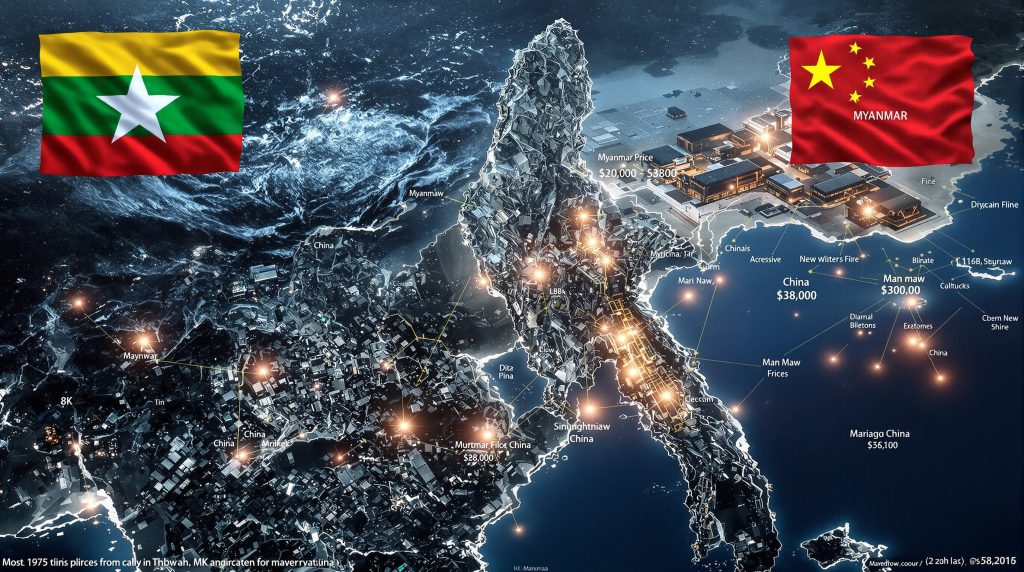The Strategic Importance of Myanmar's Tin Market
Myanmar has emerged as a critical player in the global tin market, becoming a pivotal supply source that significantly influences global tin prices and availability. The country's tin industry, particularly concentrated in the semi-autonomous Wa State region, creates ripple effects throughout global supply chains when production fluctuates. This strategic importance stems from Myanmar's position as a primary supplier to China, the world's largest tin consumer.
Why Myanmar's Tin Production Matters Globally
Myanmar's tin production holds significant weight in global markets for several reasons:
-
Accounts for approximately 10-15% of global tin concentrate supply
-
Provides roughly 70% of China's imported tin concentrates during peak production
-
Offers high-grade ore with concentrates typically containing 55-65% tin
-
Serves as a swing producer that can rapidly impact commodity market volatility
What Happened to the Man Maw Mine?
The Suspension That Shocked Global Markets
In August 2023, authorities in Myanmar's Wa State ordered the suspension of operations at the Man Maw mine, one of the world's largest tin producers. This decision sent shockwaves through global markets, triggering significant price volatility and supply concerns among downstream users.
Key Events in the Man Maw Mine Closure Timeline
The closure and its aftermath unfolded through several critical events:
-
August 2023: Wa State authorities suspended mining operations for a comprehensive resource audit
-
March 2025: A significant earthquake struck the region, potentially complicating resumption plans
-
July 2025: First new mining permits were granted to selected operators
-
September 2025: Production remains significantly below historical levels despite permit issuance
Why Was Production Halted?
The suspension stemmed from multiple factors including:
-
Resource conservation concerns after years of intensive extraction
-
Regulatory restructuring to increase government revenue from mining operations
-
Environmental impact assessments following reports of ecological damage
-
Geopolitical considerations related to China-Myanmar relations
How Has the Global Tin Market Responded?
Price Volatility and Speculative Activity
The uncertainty surrounding Myanmar's tin production has created significant market volatility, with prices fluctuating between $30,000 and $38,000 per metric ton throughout 2025. This instability has attracted speculative investment, with fund positions on the London Metal Exchange (LME) reaching multi-year highs.
LME Tin Price Movements in 2025
| Period | Price Range (USD/ton) | Key Driver |
|---|---|---|
| January-March | $30,000-$34,000 | Initial Myanmar uncertainty |
| April | Below $30,000 | Temporary market optimism |
| May-August | $30,000-$35,000+ | Continued production shortfall |
| Late August | Above $35,000 | Speculative positioning |
How Have Funds Positioned Themselves?
The continued uncertainty has rekindled significant speculative interest:
-
Long positions increased to 4,515 contracts (equivalent to 22,575 tons)
-
Short positions reduced to just 610 contracts
-
Net positioning reached levels not seen since March 2025
-
Speculators betting on prolonged production disruption
What's Happening with China's Tin Supply Chain?
The Dramatic Decline in Myanmar Imports
China's tin concentrate imports from Myanmar have collapsed since the Man Maw suspension, creating significant challenges for Chinese smelters and downstream industries. Official data shows Myanmar exports to China fell to just 933 tons in July 2025, a staggering 94% reduction from pre-suspension monthly averages of 15,000 tons.
China's Monthly Tin Concentrate Imports from Myanmar
-
Pre-suspension average (2022-2023): ~15,000 tons monthly
-
July 2025: Just 933 tons (94% reduction)
-
Year-to-date 2025: 14,200 tons (77% decrease year-on-year)
How Are Chinese Smelters Adapting?
Chinese smelters have implemented several strategies to navigate the supply disruption:
-
Diversifying supply sources with increased imports from the Democratic Republic of Congo, Australia, and Nigeria
-
Reducing capacity utilization to below 70% in many facilities
-
Implementing maintenance shutdowns to align with raw material availability
-
Depleting inventory buffers to critical levels (below 30 days for many operators)
Which Alternative Suppliers Are Filling the Gap?
The Rise of New Supply Sources
The Man Maw disruption has accelerated the development of alternative tin concentrate sources, reshaping global mining landscape and supply chains.
Emerging Tin Concentrate Suppliers to China
| Country | 2025 YTD Supply Change | Key Characteristics |
|---|---|---|
| Democratic Republic of Congo | Largest single supplier | Political risk, infrastructure challenges |
| Australia | Sharp increase | Higher production costs, stable jurisdiction |
| Nigeria | Significant growth | Emerging producer, quality variability |
| Indonesia | 64% increase in refined exports | Primarily refined metal rather than concentrate |
What Challenges Do These Alternatives Face?
While alternative suppliers have increased production, several limitations exist:
-
Higher production costs compared to Myanmar's operations
-
Infrastructure and logistics constraints limiting rapid expansion
-
Quality inconsistencies requiring smelter adaptations
-
Political and regulatory uncertainties in some jurisdictions
Is There a Global Tin Shortage?
Supply Chain Resilience Despite Disruption
Despite the significant reduction in Myanmar's output, the global tin market has shown remarkable resilience, with limited evidence of acute physical shortages.
Key Indicators of Market Balance
-
Global exchange inventories stable above 11,000 tons for three months
-
Significantly higher than the 1,000-ton scarcity levels seen in 2021
-
Indonesian refined tin exports recovered by 64% year-on-year
-
Demand moderation in electronics sector due to US-China trade tensions
Why Hasn't a Shortage Materialized?
Several factors have prevented a more severe market disruption:
-
Inventory buffers throughout the critical minerals supply chain
-
Production increases from alternative suppliers
-
Demand moderation in key consuming sectors
-
Recycling and substitution efforts by end-users
When Will Myanmar's Tin Production Recover?
The Uncertain Path to Resumption
While new mining permits have been issued for the Man Maw area, significant uncertainty remains about the timeline and scale of production recovery.
Factors Influencing Recovery Timeline
-
Regulatory requirements for new permit holders
-
Infrastructure rehabilitation needs following earthquake damage
-
Labor force mobilization challenges in the remote region
-
Potential resource quality changes after the extended closure
What Are Industry Experts Forecasting?
Industry analysts have divergent views on the recovery timeline:
-
Optimistic scenario: Gradual production increase starting Q4 2025
-
Moderate scenario: Limited production until mid-2026
-
Conservative scenario: Structural shift to permanently lower output
How Is This Affecting Downstream Industries?
Electronics Sector Adaptations
The electronics industry, which uses tin primarily for soldering circuit boards, has implemented various strategies to manage supply uncertainty.
Key Adaptation Strategies
-
Inventory building during periods of price weakness
-
Qualification of alternative tin sources with different impurity profiles
-
Development of recycling programs to recover tin from manufacturing waste
-
Research into solder formulations requiring less tin
Which Industries Are Most Vulnerable?
Certain sectors face greater challenges from tin supply disruptions:
-
Consumer electronics manufacturers with just-in-time inventory systems
-
Automotive electronics suppliers facing quality certification requirements
-
Solar panel producers using tin-based connection technologies
-
Specialty tin chemical manufacturers requiring specific purity levels
What's the Outlook for Global Tin Markets?
Market Balancing Factors for 2026
The global tin market faces competing forces that will determine price direction and supply adequacy in the coming year. According to recent analysis from Mining.com, the market remains highly dependent on developments at the Myanmar mine.
Supply-Side Developments
-
Potential gradual recovery of Myanmar production
-
New projects advancing in Australia, Africa, and South America
-
Indonesian export policies affecting refined metal availability
-
Recycling rates increasing with sustained high prices
Demand-Side Considerations
-
Electronics sector growth projections
-
Energy transition applications requiring tin
-
Potential substitution at sustained high prices
-
Impact of commodity prices impact on industrial demand
Price Forecast Scenarios
| Scenario | Price Range (USD/ton) | Key Assumptions |
|---|---|---|
| Bullish | $35,000-$40,000 | Prolonged Myanmar disruption, strong demand |
| Base Case | $30,000-$35,000 | Gradual Myanmar recovery, moderate demand |
| Bearish | $25,000-$30,000 | Faster Myanmar recovery, demand weakness |
FAQs About Myanmar's Tin Market
What makes Myanmar's tin deposits unique?
Myanmar's tin deposits, particularly in the Man Maw area, feature exceptionally high grades compared to global averages. The ore typically contains 3-5% tin content, significantly higher than the 0.5-1% found in many other regions. This high grade makes the deposits economically viable despite their remote location and infrastructure challenges.
How does political instability affect Myanmar's tin production?
The semi-autonomous Wa State, controlled by the United Wa State Army, operates with significant independence from Myanmar's central government. This creates a complex political environment where mining regulations, taxation, and export policies can change rapidly based on local authority decisions rather than national mining frameworks.
What environmental concerns surround tin mining in Myanmar?
Tin mining in Myanmar has faced criticism for environmental impacts including deforestation, water pollution from tailings, and land degradation. The regulatory suspension provided an opportunity to reassess environmental management practices, though implementation of improved standards remains uncertain.
How do seasonal factors affect Myanmar's tin production?
Myanmar's tin production follows strong seasonal patterns due to the monsoon climate. The rainy season (May-October) typically reduces production due to flooding risks and transportation difficulties on unpaved roads. This seasonality adds another layer of complexity to supply forecasting.
What role do Chinese investors play in Myanmar's tin industry?
Chinese companies and investors have significant involvement in Myanmar's tin sector, providing capital, equipment, and technical expertise. Many mining operations are joint ventures between local entities and Chinese partners, creating complex cross-border business relationships that influence industry evolution trends and production decisions.
Further Exploration:
Readers interested in learning more about global tin markets can also explore related educational content from Reuters, which provides timely updates on developments in Myanmar's tin industry including the latest on production resumption efforts.
Want to Spot the Next Major Mineral Discovery?
Discover why significant mineral discoveries like those in Myanmar's tin market can lead to exceptional investment returns by exploring Discovery Alert's dedicated discoveries page, where their proprietary Discovery IQ model delivers real-time alerts on ASX mineral announcements to position you ahead of the market.




